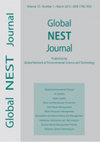HYDROTHERMAL SYNTHESIS OF IRON OXIDE PHOTO-FENTON CATALYSTS: THE EFFECT OF PARAMETERS ON MORPHOLOGY, PARTICLE SIZE AND CATALYTIC EFFICIENCY
IF 1.2
4区 环境科学与生态学
Q4 ENVIRONMENTAL SCIENCES
引用次数: 1
Abstract
Iron oxide materials were synthesized by an easy and rapid hydrothermal method using different iron precursors (FeCl3∙6H2O, Fe(NO3)3∙9H2O and K4Fe(CN)6∙3H2O), solution pHs (acid and basic) and reaction times (3 h and 6 h). The synthesized materials were thoroughly characterized by transmission electron microscopy and it was found that, depending on the synthesis conditions, iron oxide samples with crystalline or with amorphous structures could be obtained. Except for the materials synthesised from K4Fe(CN)6∙3H2O and FeCl3∙6H2O under acidic conditions all the samples show mean particle sizes below 70 nm. The materials were further tested as catalysts for the degradation of 100 mg l -1 diphenhydramine aqueous solutions by the photoFenton process at 25 °C, pH = 2.8, 100 mg l -1 of catalyst and 16 mM of H2O2 concentration. The best results in terms of pollutant removal and mineralization extent were obtained with the catalysts prepared from Fe(NO3)3∙9H2O and K4Fe(CN)6∙3H2O, under basic conditions, after 3 h of synthesis reaction time (complete degradation of diphenhydramine and total organic carbon removal higher than 60% after 60 min of reaction). Leaching of iron species from these catalysts was measured below 1.5 mg l -1 , a水热合成氧化铁光fenton催化剂:参数对形貌、粒径及催化效率的影响
采用不同的铁前体(FeCl3∙6H2O、Fe(NO3)3∙9H2O和K4Fe(CN)6∙3H2O)、溶液ph(酸碱性)和反应时间(3 h和6 h),采用简单快速的水热法合成了氧化铁材料。通过透射电镜对合成的材料进行了全面表征,发现根据合成条件的不同,可以得到晶态或非晶态结构的氧化铁样品。除在酸性条件下由K4Fe(CN)6∙3H2O和FeCl3∙6H2O合成的材料外,所有样品的平均粒径均小于70 nm。在25°C、pH = 2.8、催化剂浓度为100 mg l -1、H2O2浓度为16 mM的条件下,对材料进行光芬顿法降解100 mg l -1苯海拉明水溶液的实验。以Fe(NO3)3∙9H2O和K4Fe(CN)6∙3H2O为原料制备的催化剂,在基本条件下,经过3 h的合成反应时间(反应60 min后苯海拉明完全降解,总有机碳去除率大于60%),对污染物的去除率和矿化程度最好。这些催化剂的铁类浸出量低于1.5 mg l - 1,a
本文章由计算机程序翻译,如有差异,请以英文原文为准。
求助全文
约1分钟内获得全文
求助全文
来源期刊

Global Nest Journal
环境科学-环境科学
CiteScore
1.50
自引率
9.10%
发文量
100
审稿时长
>12 weeks
期刊介绍:
Global Network of Environmental Science and Technology Journal (Global NEST Journal) is a scientific source of information for professionals in a wide range of environmental disciplines. The Journal is published both in print and online.
Global NEST Journal constitutes an international effort of scientists, technologists, engineers and other interested groups involved in all scientific and technological aspects of the environment, as well, as in application techniques aiming at the development of sustainable solutions. Its main target is to support and assist the dissemination of information regarding the most contemporary methods for improving quality of life through the development and application of technologies and policies friendly to the environment
 求助内容:
求助内容: 应助结果提醒方式:
应助结果提醒方式:


